Overshadowed here by legislative debate over possible death-penalty reforms, a milestone in the history of the American death penalty has been sneaking up on us. Nebraska's legislators are expected to vote this spring to quit using the electric chair, sanctioning a switch to lethal injection as the state's execution method of choice. Nebraska will be the last death-penalty state to make that switch. Consumed by a budget crisis, lawmakers gave electrocution a reprieve until January. But it's clear that, very soon, the era of the electric chair--the most symbolically potent execution method since the guillotine--will come to an end.
Granted, condemned men and women are still free to choose the chair in several states, but they rarely do so. It's possible that the last person in human history deliberately killed with a burst of electricity will have been Lynda Lyon Block, whom Alabama executed last May, just before that state also changed over to lethal injection. Illinois hasn't used the electric chair in 40 years, but between 1928 and 1962 electric chairs at three state prisons executed 96 men and two women.
The end of the electric chair is an occasion for humility. That's because it's now clear that the chair--first used in 1890--was a 113-year mistake. No other country followed our lead in adopting it. The electric chair was not only a moral outrage: It was an actual mistake--it never worked as advertised. The story of how we got duped into thinking it would work--and why it took so long to correct our error--is an odd, sad tale about blind faith in technology and behind-the-scenes maneuvering by unprincipled corporate leaders, including Thomas Edison. And it makes you wonder, given our capacity for self-delusion, what we are blind to today as we consider the death penalty and the various methods of carrying it out.
The father of the electric chair was a dentist by the name of Alfred Southwick. He lived in Buffalo, New York, and had also been trained as an engineer. His macabre "eureka" moment came in 1881, when he saw a drunk stumble into an uninsulated electric wire and get killed instantly (and, Southwick guessed, painlessly). The culture was on the lookout for a new execution method, as Americans were beginning to view hanging as a medieval throwback. Stories of torturous strangulations or surprise decapitations--the all-too-common results of hangings gone wrong--were widely disseminated. In 1834, the New York legislature had come within three votes of banning capital punishment altogether, precisely because of public disgust over such barbarities.
In this environment, Southwick's peculiar idea gained a foothold--and some odd cheerleaders. One of the most distasteful was a gung-ho engineer named Harold Brown, who rented out an auditorium at Columbia University, affixed wires to cages holding dogs, and killed them before horrified audiences--even jaded reporters shouted at him to stop--to demonstrate the efficacy of electrocution.
In 1888, a committee appointed by New York governor David Bennet Hill endorsed electrocution. The next year, the sadist Brown, in the journal North American Review, painted a picture of the new world of executions, capturing well the optimism of the era: "Dials of electrical instruments indicate that all the apparatus is in perfect order and record the pressure at every moment," he wrote, rapturously. "The deputy-sheriff throws the switch. Respiration and heart activity instantly cease. There is a stiffening of the muscles but there is no struggle and no sound. The majesty of the law has been vindicated, but no physical pain has been caused--such is electrical execution." Like others, Brown assumed that a painful electrocution was an impossibility, since electricity traveled faster than nerve impulses.
Yet the very first electrocution, on August 6, 1890, in New York's Auburn Penitentiary, was "so terrible," the New York Times reported, "that the word fails to convey the idea." After the first 1,000-plus volt jolt of electricity, ax-murderer William Kemmler started twitching, and witnesses screamed. The executioners slammed down the switch again. Kemmler's blood vessels broke, pushing blood through the skin. His skin and hair burned, and a stench filled the room. The electricity magnate George Westinghouse later offered this pithy summary of the ghastly scene: "They would have done better with an ax." Yet New York persuaded itself that the method was not at fault: Human error had simply slipped into the proceedings.
But Kemmler's death, not the North American Review's fantasy, became the model for subsequent electrocutions. "Botched" electric chair episodes were so common as to be the norm. Executions that went "smoothly" were still brutal. By the 1990s, even grizzled judges in the Deep South started saying enough is enough. What had gone wrong? On a technical level, the problems with the electric chair were simple enough. Electricity doesn't kill by "frying" the brain or "polarizing" nerves or whatever else people usually think. As Theodore Bernstein, a retired University of Wisconsin engineer--and one of the few scholars to study the electric chair--has explained, electricity kills by disrupting the beating of the heart. The heart, though, can snap back from even a large shock. In a grim twist, it is especially likely to bounce back if another large shock is administered. (Think of an emergency medical technician applying a defibrillator to a patient's chest.) The typical American electrocution involves delivering several shocks of varying intensity. And so the electric chair was designed in such a way that it would kill, revive, and kill again. That huge levels of voltage might sometimes cause burns should not exactly have stunned anyone.
Why did it take a century to figure this out? Anyone who read about Kemmler's fate should have suspected something was amiss. In a recent issue of the Journal of American History, German historian Jurgen Martschukat offers one explanation for why Americans failed to see what was before our eyes: technological intoxication. The 1870s and '80s, he reminds us, were decades that witnessed awesome, even sublime, technical advances. People who saw outdoor lighting for the first time would sometimes drop to their knees and cross themselves. One problem after another fell before the creativity of hero-engineers. In such an environment, to suggest that electricity might contribute to a step backward just didn't compute.
Yet Americans weren't only blindered. Some powerful forces were also working hard to obscure the truth about electrocution, as Mount Holyoke College sociologist Richard Moran explains in a fascinating new book, Executioner's Current: Thomas Edison, George Westinghouse, and the Invention of the Electric Chair (Knopf). Moran argues that New York might not have adopted electrocution--many leading citizens preferred to stick with hanging--had Edison, American hero, not put his considerable clout behind it. But Edison's intentions were entirely ignoble, as Moran meticulously documents.
Edison wanted New York to execute its criminals using the technology of his corporate rival, Westinghouse--against Westinghouse's wishes. Edison wasn't motivated by an interest in reducing the cruelty of the death penalty. Rather, he hoped Westinghouse's technology of alternating current, which was commercially clobbering Edison's direct current, would be tarnished by an association with state-sponsored death. (Hence the title of Moran's book: Would you want the "executioner's current" running through your children's bedroom walls? Call it an early negative ad campaign.) It was Edison who, on the sly, paid Harold Brown to publicly execute those dogs--and later calves and horses--in experiments rigged to make Westinghouse's current look deadlier than Edison's.
Edison won the battle but lost the war. Westinghouse won the competition to light America. The collateral damage from this corporate clash was the infliction of the electric chair upon America.
Our 19th century predecessors let themselves believe they could solve the moral problems of the death penalty through technology. Once they'd instituted the "solution," they let wishful thinking continue to blind them to bloody reality. Soon Nebraska will join the ranks of states that think they've resolved their problems by switching to lethal injection. Have they succeeded this time around--or simply updated our nation's self-delusion?




















